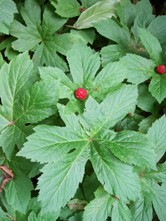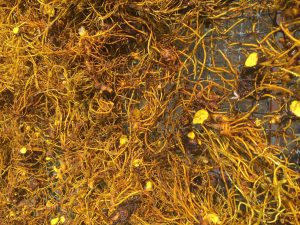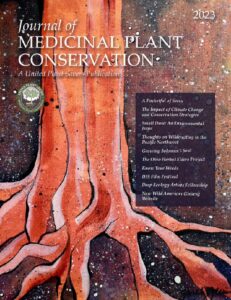
Overall At-Risk Score: 50
Latin Name:
Hydrastis canadensis (IPNI, 2020)
Common Name(s):
Goldenseal, Yellow Root, Ground Raspberry, Wild Curcuma, Yellow Paint (Persons & Davis, 2014).
Family:
Ranunculaceae (USDA, 2020).
Part(s) of Plant Used:
Rhizome and fibrous roots (Burkhart & Jacobson, 2006).

Geographic Region(s):
Found in most of the Eastern hardwood forests, including Alabama, Arkansas, Connecticut, Delaware, Georgia, Illinois, Indiana, Iowa, Kansas, Kentucky, Maryland, Massachusetts, Michigan, Mississippi, Missouri, New Jersey, New York, North Carolina, Ohio, Oklahoma, Pennsylvania, Tennessee, Vermont, Virginia, West Virginia, and Wisconsin (USDA, 2020).
It is also found in the southwestern area of the province of Ontario (Robbins, 2000).
Habitat:
Goldenseal is typically found growing on forested slopes, along stream banks, and in rich open woodlands (Sievers, 1949; McGraw et al., 2003), on north, northeast, and east facing aspects under a mature forest canopy that provides approximately 60%-80% shade (Persons & Davis, 2005).

Life History:
Goldenseal is a slow growing, long lived herbaceous perennial. Each fall it’s leaves and stem die back, leaving a cup-like scar on the perennial rhizome that looks like an old wax seal, hence where the name goldenseal is derived from (Albrecht & McCarthy, 2006; COSEWIC, 2019; Persons & Davis, 2005).
Goldenseal’s life cycle can be separated into three distinct stages of development: the seedling stage, the juvenile stage, and the reproductive stage. Following seed germination, plants can remain in the seedling stage of development for 1 to 2 years depending on the quality of the growing site. Seedlings do not develop a true leaf during the first year of growth, but instead persist with two small, round leaf like cotyledons. After 2 to 3 years of growth, plants reach the juvenile stage of development, which is marked by the development of a single palmately-lobed leaf (Burkhart & Jacobson, 2006). Plants will generally persist in the juvenile phase for 1 to 2 years before becoming fully mature. After 4 to 6 years of growth, plants will finally become sexually reproductive and will develop a forked stem with two leaves that each have 5-7 lobes, one leaf is smaller than the other and bears a small white flower (Chafin, 2007; Foster & Duke, 2014). The single white flower with showy white stamens blooms almost immediately after the plant emerges and begins to unfurl its leaves in April. Goldenseal flowers are pollinated by small bees and syrphid flies but are also capable of self-fertilization (Chafin, 2007). The fruit, a raspberry-like drupe, matures through the summer months, turning from green to red before ripening in mid-to late July (Van der Voort et al., 2003). The seeds, which resemble shiny black BB’s, can exhibit single or double dormancy, with most seeds germinating the first spring if stratification requirements are met (Persons and Davis, 2005; Albrecht & McCarthy, 2011). Although goldenseal can reproduce via seed production, most natural population growth occurs through clonal propagation (Van der Voort et al., 2003; Burkhart & Jacobson 2006) were adventitious buds form along the fibrous roots and eventually swell to emerge as a new plant (Albrecht & McCarthy, 2006).
Endangered/Threatened/Trade Status:
Goldenseal is listed as of “Special Concern” in Tennessee, as “Threatened” in Maryland, Michigan, and New York, and is “Vulnerable” in Pennsylvania (USDA, 2020).
Goldenseal is Endangered in Connecticut, Georgia, Maine, Massachusetts, Minnesota, New Jersey, and North Carolina (USDA, 2020).
Listed as of special concern in Canada by The Committee on the Status of Endangered Wildlife in Canada (COSEWIC), and as threatened under Schedule 4 of the Ontario Endangered Species Act 2007 (COSEWIC, 2019).
Vulnerable (Global): IUCN Red List of Threatened Species (Oliver, 2000).
Appendix II, Convention on the International Trade of Endangered Species (CITES) (Robbins, 2000).
Ability to Withstand Disturbance:
Due to Goldenseal’s ability to propagate vegetatively by rhizome and fibrous roots, some kinds of soil disturbance can stimulate growth and increase the number of plants by breaking off root fragments (Robbins, 2000). That being said, Goldenseal is very sensitive to overharvest due to it being slow growing, having a long life span, and low fecundity, it will take many years to grow back to the previous population size (Albrecht & McCarthy, 2006).
Studies have shown that an increase in foot traffic on new trails in the area has a small impact on the available growing space for the population, but a much larger issue is an increasing amount of edge habitat. Goldenseal is endemic to older stands of forest and relies on an open understory and heavy leaf litter that can only be found deeper in the forests. The destruction of Eastern hardwood forests from logging and overdevelopment has led to much of Goldenseal’s previously arable land becoming inhabitable for the species (Sinclair & Catling, 2000).
Vulnerabilities and Threats:
Goldenseal is considered to be one of the most at-risk medicinal plants in the United States and is estimated to be at a high risk of extinction through its native range (Oliver, 2017). The historic and continued loss of Goldenseal’s habitat is one of the leading causes of this species’ decline (Robbins, 2000), as well as millions of rhizomes being wild harvested each year to supply the commercial herb market (Albrecht & McCarthy, 2006). According to a study in Ohio, almost one half of recorded Goldenseal populations have disappeared (Robbins, 2000).
Demand:
Goldenseal rhizomes have been harvested for centuries and are in even higher demand today, with millions of rhizomes being wild harvested each year to supply the commercial herb market (Albrecht & McCarthy, 2006).
According to a tonnage survey done by the American Herbal Products Association (AHPA), between 1999-2010 an average of 63,797 pounds of dried rhizome & root were wild-harvested each year (AHPA, 2012). These numbers only reflect the people who participated in the survey and do not account for all harvested material. There are around 500 rhizomes per dried pound of wild-simulated goldenseal (Burkhart & Jacobson, 2006), therefore 63,797 pounds x 500 plants per pound would equal over 31 million goldenseal plants being wild-harvested annually.
In a study by Kruger and Munsell (2015), they recorded 73,367 dry pounds of goldenseal that had been wild-harvested in 2015, and estimated that is only 14.3% of total pounds actually harvested.
It is incredibly important for commercial and private harvest to be restricted to cultivated patches of Goldenseal.
Wild Harvesting and Impact on Other Species:
Goldenseal is an important plant for the forage cycles of native insects and birds. Foot traffic when foraging for the plant and the removal methods used to harvest Goldenseal cause soil disturbance that can be harmful to other nearby plants (Albrecht & McCarthy, 2006).
Lookalike(s):
Not Available
Status Recommendation:
At-Risk
References:
- Albrecht, Matthew & McCarthy, Brian. (2009). Comparative Analysis of Goldenseal (Hydrastis canadensis L.) Population Re-growth Following Human Harvest: Implications for Conservation. The American Midland Naturalist. 156(2), 229-236.
- Albrecht, M.A., & McCarthy, B.C. (2011). Variation in dormancy and germination in three co-occurring perennial forest herbs. Plant Ecology, 212(9), 1465-1477.
- American Herbal Products Association (AHPA). Tonnage Surveys of Select North American Wild-Harvested Plants, 2006–2010. Silver Spring, MD: American Herbal Products Association. 2012.
- Burkhart, E. & Jacobson, M. (2006). Non-Timber Forest Products (NTFPs) from Pennsylvania: Goldenseal (Hydrastis canadensis).
- Chafin, L. (2007). Goldenseal: Hydrastis canadensis. Georgia Wildlife Resources Division.
- Committee on the status of Endangered Wildlife in Canada (COSEWIC). (2019, December 20th). COSEWIC Assessment and Status Report on the Goldenseal (Hydrastis canadensis) in Canada 2019. Available at https://www.canada.ca/en/environment-climate-change/services/species-risk-public-registry/cosewic-assessments-status-reports/goldenseal-2019.html [Accessed 05/20/2020].
- Foster, Steven & A. Duke, James. (2014). Peterson Field Guide to Medicinal Plants and Herbs: Eastern and Central North America.
- Kruger, S., & Munsell, J. (2015). Root Report: Preliminary Results for 2014.
- McGraw, J., Sanders, S., Van der Voort, M. (2003). Distribution and abundance of Hydrastis canadensis (Ranunculaceae) and Panax quinquefolius L. in the Central Appalachian Region.
- Missouri Botanical Garden. (n.d.). Hydrastis canadensis – Plant Finder. Available at http://www.missouribotanicalgarden.org/PlantFinder/PlantFinderDetails.aspx?kemperc%09ode=k570 [Accessed 05/20/2020].
- Oliver, L. (2017). Hydrastis canadensis. The IUCN Red List of Threatened Species 2017.
- Persons, W.S. and Davis, J.M.. (2005). Growing and Marketing Ginseng, Goldenseal, and Other Woodland Medicinals. Bright Mountain Books, Fairview, NC.
- Robbins, C.S. (2000). Comparative analysis of management regimes and medicinal plant trade monitoring mechanisms for American ginseng and goldenseal. Conservation Biology, 14(5), 1422-1434.
- Sievers, A. (March, 1949). Goldenseal Under Cultivation. USDA Farmers’ Bulletin. No. 613.
- Sinclair, Adrianne & Catling, Paul. (2000). Ontario Goldenseal, Hydrastis canadensis, populations in relation to habitat size, paths, and woodland edges. Canadian Field-Naturalist. 114. 652-655.
- USDA NRCS. (n.d.). Hydrastis canadensis goldenseal. Available at https://plants.usda.gov/core/profile?symbol=hyca [Accessed 05/20/2020].
- Van Der Voort, M, et al. (2003). Recovery of populations of Goldenseal (Hydrastis canadensis ) and American Ginseng (Panax quinquefolius) following harvest. The American Midland Naturalist, 149(2):282-292.
Additional Source(s) of Interest:
The Forest Farmers Handbook: A beginners Guide to Growing and Marketing At-Risk Forest Herbs by Rural Action and United Plant Savers. Purchase yours here: https://www.amazon.com/Forest-Farmers-Handbook-United-Savers/dp/1670745732
Goldenseal Podcast 1- The Plant Detective by Flora Delaterre
Goldenseal Podcast 2 – The Plant Detective by Flora Delaterre
Related Posts
Rural Action and United Plant Savers received a two-year grant to study Goldenseal propagation from the USDA Ohio Specialty crop grant program.
Rural Action and United Plant Savers will conduct research into multiple cultivation methods for the commercially valuable forest crop goldenseal, Hydrastis canadensis.
Cultivation Demonstration Videos
These videos will walk you through the lifecycle, site selection, planting techniques and maintenance of ramps, ginseng and goldenseal as outlined in The Forest Farmers …
Goldenseal Cultivation
By Jennifer Gerrity Herb Pharm expanded a planting of goldenseal (Hydrastis canadensis) roots from nursery stock this fall on private land in SW Virginia. The …






